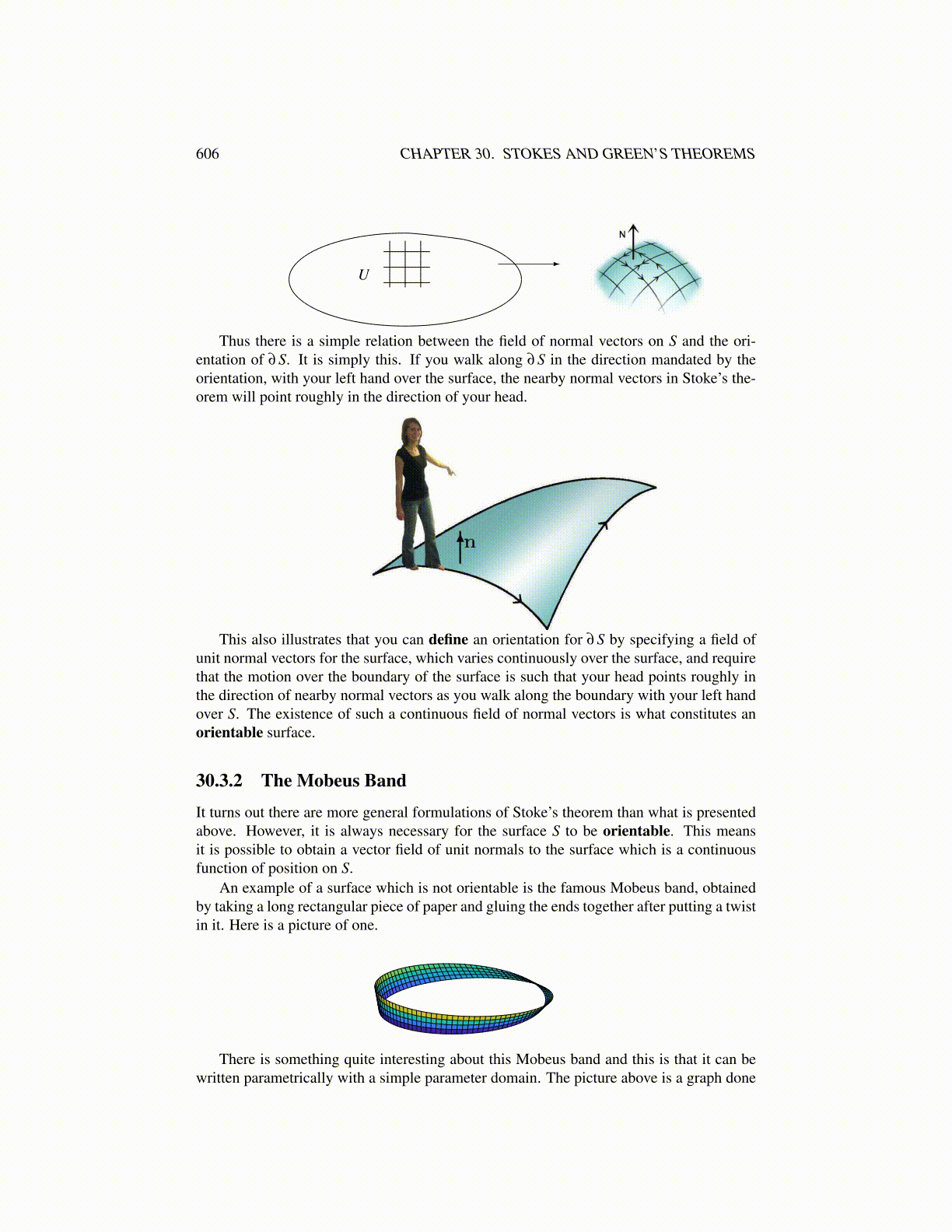
606 CHAPTER 30. STOKES AND GREEN’S THEOREMS
Since U is open, for small t, the ball of radius |t| centered at x is contained in U . Therefore,the line segment from x to x+ tei is also contained in U and so one can take
p(x,x+ tei)(s) = x+ s(tei)
for s ∈ [0,1]. Therefore, the above difference quotient reduces to
1t
∫ 1
0F (x+ s(tei)) · tei ds =
∫ 1
0Fi (x+ s(tei)) ds = Fi (x+ st (tei))
by the mean value theorem for integrals. Here st is some number between 0 and 1. Bycontinuity of F, this converges to Fi (x) as t → 0. Therefore, ∇φ = F as claimed.
Conversely, if ∇φ = F, then if R : [a,b]→ Rp is any C1 curve joining x to y,∫ b
aF (R(t)) ·R′ (t) dt =
∫ b
a∇φ (R(t)) ·R′ (t) dt =
∫ b
a
ddt
(φ (R(t))) dt
= φ (R(b))−φ (R(a)) = φ (y)−φ (x)
and this verifies 30.3 in the case where the curve joining the two points is smooth. Thegeneral case follows immediately from this by using this result on each of the pieces of thepiecewise smooth curve. For example if the curve goes from x to p and then from p to y,the above would imply the integral over the curve from x to p is φ (p)−φ (x) while from pto y the integral would yield φ (y)−φ (p). Adding these gives φ (y)−φ (x). The formula30.3 implies the line integral over any closed curve equals zero because the starting andending points of such a curve are the same.
Example 30.5.4 Let
F (x,y,z) = (cosx− yzsin(xz) ,cos(xz) ,−yxsin(xz)) .
Let C be a piecewise smooth curve which goes from (π,1,1) to(
π
2 ,3,2). Find
∫C F · dR.
The specifics of the curve are not given so the problem is nonsense unless the vectorfield is conservative. Therefore, it is reasonable to look for the function φ satisfying ∇φ =F. Such a function satisfies φ x = cosx− y(sinxz)z and so, assuming φ exists, φ (x,y,z) =sinx+ycos(xz)+ψ (y,z) . I have to add in the most general thing possible, ψ (y,z) to ensurepossible solutions are not being thrown out. It wouldn’t be good at this point to only add ina constant since the answer could involve a function of either or both of the other variables.Now from what was just obtained, φ y = cos(xz) +ψy = cosxz and so it is possible totake ψy = 0. Consequently φ , if it exists, is of the form φ (x,y,z) = sinx+ ycos(xz) +ψ (z) . Now differentiating this with respect to z gives φ z =−yxsin(xz)+ψz =−yxsin(xz)and this shows ψ does not depend on z either. Therefore, it suffices to take ψ = 0 andφ (x,y,z) = sin(x)+ ycos(xz) . Therefore, the desired line integral equals
sin(
π
2
)+3cos(π)− (sin(π)+ cos(π)) =−1.
The above process for finding φ will not lead you astray in the case where there doesnot exist a scalar potential. As an example, consider the following.
Example 30.5.5 Let F (x,y,z) =(x,y2x,z
). Find a scalar potential for F if it exists.
If φ exists, then φ x = x and so φ = x2
2 +ψ (y,z). Then φ y = ψy (y,z) = xy2 but thisis impossible because the left side depends only on y and z while the right side dependsalso on x. Therefore, this vector field is not conservative and there does not exist a scalarpotential.